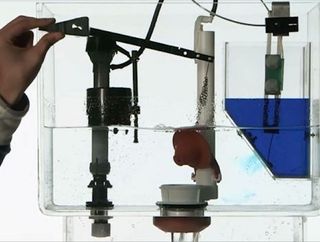These 3 Student Inventions May Make Life Easier

If you've ever wished for an invention that could make life a little bit easier, take heart.
Some of those dreams might become reality, thanks to a few engineering students at The Cooper Union in New York City, who, as part of a college competition, came up with a host of products that could save both time and energy. They pitched their ideas to Quirky, a New York City-based startup that helps bring inventions to market, which selected a handful of them for possible mass production.
Here are a few of the inventions they hope to bring to the world:
Dual-flush toilet converter
One pair of students developed a device that converts a single-flush toilet to a dual-flush system, which saves water by giving people a choice between a full flush and a partial flush. [Top 10 Emerging Environmental Technologies]
The average American household uses 400 gallons of water per day, 70 percent of which is indoors, and more than a quarter of that is consumed by the toilet, according to the U.S. Environmental Protection Agency.
"What our dual flush attempts to do is cut back on water consumption," said Eric Nguyen, an electrical engineering student at Cooper Union, who developed the device along with fellow student Abiyaz Chowdhury.
Sign up for the Live Science daily newsletter now
Get the world’s most fascinating discoveries delivered straight to your inbox.
Other products already exist that perform the same conversion, but these require a lot of tools and labor to install. By contrast, Nguyen's and Chowdhury's device doesn't require any tools, and takes only a few seconds to install.
The dual-flush retrofit kit consists of a container that fits into the toilet tank, which contains a valve that can be opened or closed by a toggle switch. When the valve is left open, the entire tank flushes regularly (a dual flush), but when the valve is closed, a half-gallon of water (about a third of the tank's contents) is withheld from being flushed (a single flush).
"The rest of the world is already using dual-flush toilets," Nguyen told Live Science. "America seems to be one of last developed countries to step up to the plate and save water."
Universal tape dispenser
Ever find yourself with a roll of duct tape in your teeth, contorting your mouth to rip off a piece while attempting to not break a tooth? Enter another brilliant student idea.
Another team of Cooper Union students has designed a universal tape dispenser, which bills itself as "the world's best tape dispenser." The device is safe, fits with any roll of tape and prevents the user from losing the edge of the roll, say its makers, electrical engineering student Jessica Marshall and mechanical engineering student Deanna Kovalcin.
"Every [kind of] tape has a different dispenser, and a lot don't even have a dispenser," Marshall told Live Science. For example, there's no dispenser for duct tape or electrical tape, neither of which can be cut by a scotch tape blade, she said. [10 Fun (and Affordable) Ways to Spruce Up Your Home Office]
The new dispenser hooks onto a roll of tape with an elastic band and hook. It has a recessed blade, and with the push of a button, the tape gets pressed against the blade, which cuts it.
The dispenser comes in two sizes and works with basically any type of tape, Marshall said. Nothing really similar exists on the market, she added.
Easy-to-clean humidifier
No one likes waking up in the night feeling desiccated by the dry winter air, but humidifiers can be a pain in the rear to clean.
Now, Cooper Union students have designed an easy-to-clean-humidifier, or "ETCH."
"Humidifiers provide a healthier environment; cleaning them is nearly impossible," said the narrator of a video describing the new product.
Unlike current models, the new humidifier has a simple and accessible cube shape, which can be easily wiped clean. The base, which contains all the electronics, doesn't come into contact with the water, so it doesn't require cleaning.
These products may be pipe dreams for now, but all of them have been selected for potential mass production.
Follow Tanya Lewis on Twitter. Follow us @livescience, Facebook& Google+. Original article on Live Science.

